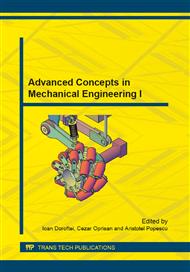[1]
C., Duca, Fl. Buium, G., Paraoaru, Critical positions and mechanism self-blocking, I, II, PRASIC Symposium, Brasov, Romania 2002, vol. I, pp.113-126.
Google Scholar
[2]
C., Duca, Fl. Buium, Critical configurations of the structural groups, Bul. Inst. Pol. Iasi, Tom LII(LVI), Fasc. 7A, 2006, pp.241-256.
Google Scholar
[3]
C., Duca, Fl. Buium, A critical position regarding the critical positions of mechanisms, Bul. Inst. Pol. Iasi, Tom LIV(LVIII), Fasc. 1, 2008, pp.248-254.
Google Scholar
[4]
C., Duca, Fl. Buium, Questions about self-blocking of mechanisms, Bul. Inst. Pol. Iasi, Tom LVI(LX), Fasc. 4A, 2010, pp.248-254.
Google Scholar
[5]
C., Duca, Fl. Buium, Forces transmission in the 0/3/3 structural group, Bul. Inst. Pol. Iasi, Tom LIX(LXIII), Fasc. 1, 2013, pp.17-22.
Google Scholar
[6]
C., Duca, Why the structural groups? (I), Bul. Inst. Pol. Iaşi, Tom LII(XLVI), 3-4, Sec. V, 1996, 2008, pp.27-34.
Google Scholar
[7]
Fl. Buium, C. Duca, G., Paraoaru, The critical configurations of the 0/3/3 structural group, PRASIC Symposium, Braşov, Romania 2002, vol. I, pp.89-92.
Google Scholar
[8]
S., Bandyopandhyay,. A., Ghosal, Analysis of configuration space singularities of closed-loop mechanisms and parallel manipulators, Mechanism and Machine Theory, 39, (2004), pp.519-594.
DOI: 10.1016/j.mechmachtheory.2003.08.003
Google Scholar
[9]
Chen-Chou Lin, Wen-Tung Chan, The force transmissivity index of planar linkage mechanisms, Mechanism and Machine Theory, 37, (2002), pp.1465-1484.
DOI: 10.1016/s0094-114x(02)00070-8
Google Scholar
[10]
Balli S. Shrivas, Chand Satish, Transmission angle in mechanisms, Mechanism and Machine Theory, 37, (2002), pp.175-195.
DOI: 10.1016/s0094-114x(01)00067-2
Google Scholar
[11]
Fr., Kovacs, A new method to verify the avoidance of blocking caused by links dimensions, (in Romanian), Buletinul Stiintific si Tehnic al Inst. Pol. Timisoara, Tom (9)23, Vol special, 1964, pp.127-136.
Google Scholar
[12]
Fr., Kovacs, A new method to verify the avoidance of blocking caused by friction forces, (in Romanian), Buletinul Stiintific si Tehnic al Inst. Pol. Timisoara, Tom (10)24, Fasc. 1, 1965, pp.131-142.
Google Scholar
[13]
M., Dragna, About mechanism self-blocking phenomenon caused by friction in sliding joints, Simpozion de mecanisme si transmisii mecanice, Timisoara 1984, pp.259-262.
Google Scholar
[14]
M., Dragna, Evaluation of critical zones of 3R dyad, The Eighth IFToMM International Symposium, Bucharest, 2001, Vol. I, pp.119-122.
Google Scholar


